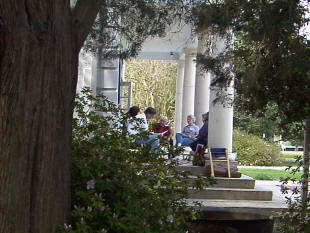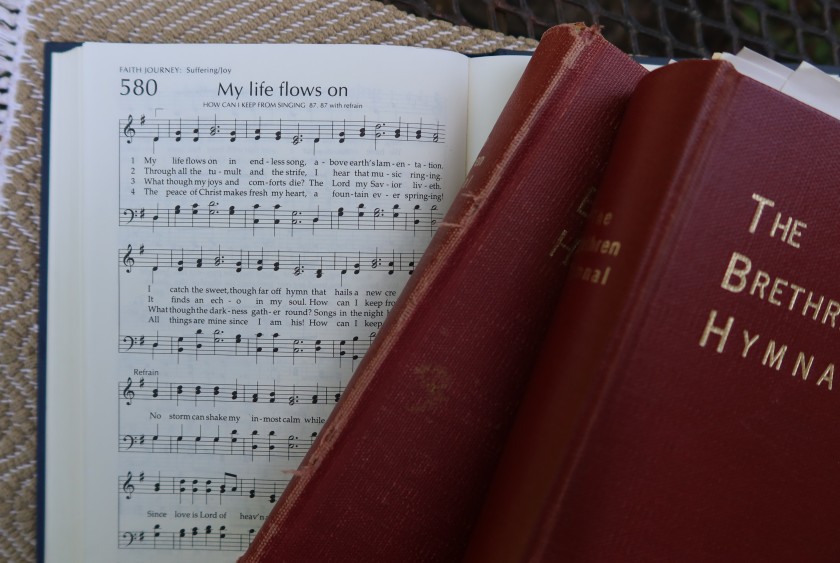“How Can I Keep From Singing” is one of my favorite hymns. During my latest project to compile a list of gospel tunes which are easy to play on the dulcimer, I immediately thought of this song becauce I like it so much. Both the melody and the words are stirring. However, I soon realized that the song is tricky to play on the dulcimer because the song has an unusual rhythm. In fact, my hymnal doesn’t even include a time signature at the beginning of this song. It doesn’t have a “march” rhythm like other fiddle tunes which we play on the dulcimer. However, I love the gospel hymn and decided to translate in into a dulcimer tablature arrangment.

The song, “How Can I Keep from Singing” is also known as “My Life Flows On.” My memory of learning and singing this is song is from church services when I was young. The general idea was that you followed the choir director and massive pipe organ and sang along. It was all you could do. Our congregation had a wonderful choir director, Dr. Nelson T. Huffman. He had wild white hair — like Albert Einstein — and a flowing black robe. He could really belt out the music. Under the directon of the church musicians, the song flowed freely — just like the lyrics.
I always assumed that this song was a contemporary hymn. However, I discovered that it is an old American tune dating to 1869. The melody was published by Robert Lowry (1826-1899) in the book, Bright Jewels for the Sunday School. The words were originally published a year earlier, in 1868, in The New York Observer, under the title of “Always Rejoicing.” The words were attributed only to “Pauline T.”
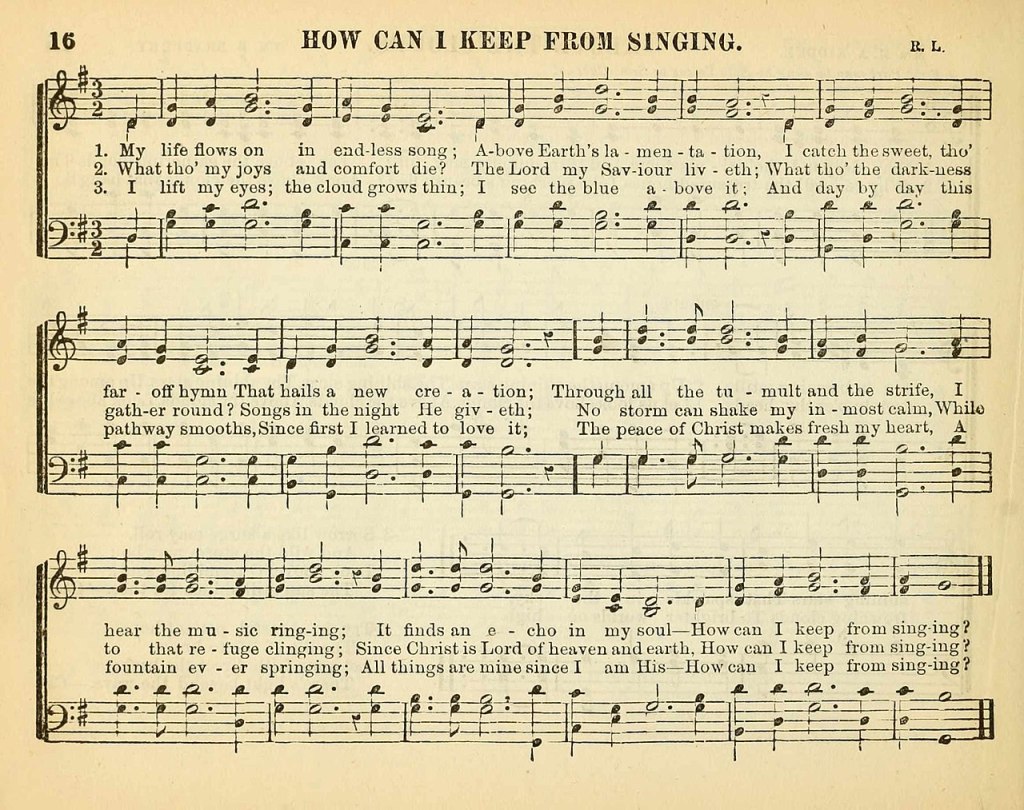
Robert Lowry was a Baptist preacher serving congregrations in Pennsylvania and New York. He was also a prolific gospel music composer and writer. His other well known tune is, “Shall We Gather at the River.” Lowry says that he really didn’t care for that hymn because it reminded him of a brass marching band. However, that style of music was popular and the song is now a gospel standard. In 1868. Lowry began serving as hymnals editor to Biglow and Main, a large hymnal publishing company in New York. Under this tenure, he published over 20 hymnals. Lowry is a important influence on American gospel music.
“How Can I Keep From Singing” wasn’t included in many hymnals until the twentieth century. Pete Seeger learned a version — with different words — from a friend who incorrectoly stated that it was a Quaker tune. The Irish singer-songwriter, Enya, picked up the song and recorded it on one of her albums in 1991, also calling it a Quaker song and using Seeger’s protest song lyrics. It becme quite a hit song for Enya, especially in the British Isles. Thus, the song is often known as a Quaker hymn.
This hymn, written in 1869, is in the public domain. Pete Seeger actually sued Enya over her use of his lyrics. However, the court ruled that since Seeger claimed that it was an “old folk tune”, then he couldn’t copyright his lyrics. Many hymnals include slightly different the lyrics other than the original ones or those of Pete Seeger. If you are using additional lyrics, check your hymnal or source to make sure that they are not copyrighted.
3/2 Time Signature
Translating this tune into dulcimer tablature was a challenge. Rather than a march tune with a regular strumming rhythm and pattern, it just flows.
The time signature for this tune in most hymnals is 3/2. In addition, in my arrangement, two measures change to a 4/4 time signature.
Songs with a 3/2 time signature have a distinctive feel. There are three beats in a measure and the half note is one beat. Although waltzes (3/4 time signature) also have three beats per measure, songs in 3/2 time are generally played a little slower. Unlike waltzes (which have an accented and driving first beat rhythm), the three half note beats in 3/2 time have equally strong downbeats. There is no “bum-ta-ta” rhythm.
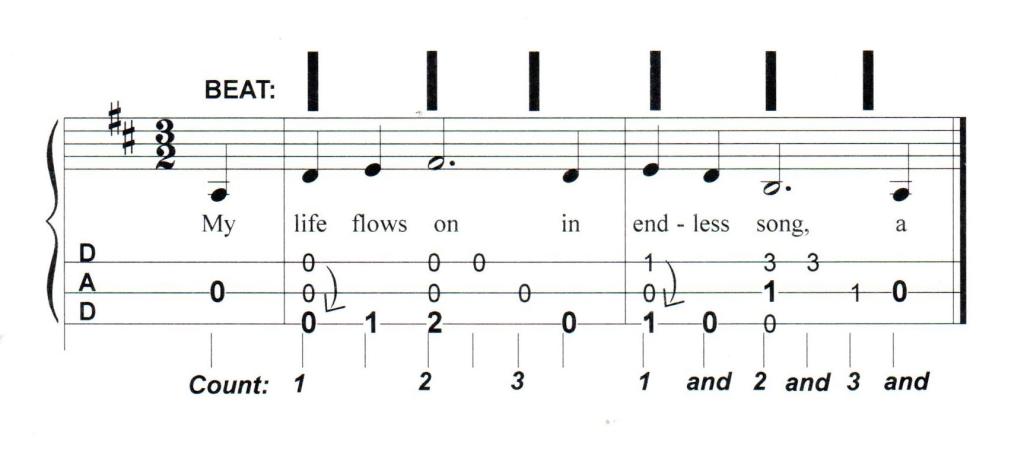
In the 3/2 time signature, each half-note beat can be subdivided into 2 quarter notes which are counted as “1 and”, “2 and,” “3 and” etc. This tune also contains lots of dotted half notes which means that this note is held further giving a “syncopated” note rhythm.
Playing the Dulcimer in the Chord-Melody Style
I asked Larry Conger, who is a master an expressive dulcimer playing, for his assessment of the song. Larry says:
We have to realize that not every song lends itself to the dulcimer’s traditional strumming style. A more tasteful and dynamic approach to certain songs might involve picking individual strings while fretting chords, in what has become known as a chord-melody style. This approach results in a more expressive melody driven sound.
Larry Conger, 2024
In the chord-melody style of playing, the melody is emphasized and other notes are filled in with notes, chords and strums. I like to fingerpick these songs, but lots of dulcimer players use a pick to sound each individual string.
Many dulcimer players use the chord-melody style of playing. I find that it is a rewarding way to play the dulcimer, especially for a solo player or duet and small ensemble group. To learn more about this style of playing, I can recommend the music of Larry Conger and Rosamond Campbell.

I am familiar with Rosamond Campbell, now deseased, who wrote a book on this method — I assisted with the typing. It is published by Mel Bay Publications who is a major publisher of dulcimer books. Campbell’s songs go from the beginning to advanced level of playing. The real gem of her book is how to “perform” the dulcimer — not just play it.
Larry Conger has authored many books using the chord-melody style of playing. His collection of copyrighted music is a treasure for anyone interested in playing music of the 20th century. These songs must be individually purchased, but are worth it if you want to play the music of contemporary artists.
For example, “Kansas City,” (shown in the photo above) written by Jerry Leiber and Mike Stroller in 1952, is a great rhythm and blues tune. It is so much fun to play on the dulcimer. Larry and Elaine Conger tabbed the song out as a duet. The melody has a complicated rhythm but the bass part is simplier and straightforward. (Although the bass part is intended for a bass dulcimer, it can also be played on a standard dulcimer.) This and Larry’s other copyrighted songs can be found on Sheet Music Plus. (See reference) (Although “Kansas City” is not a hymn — it does illustrate the Sheet Music Plus internet site.)
Playing “How Can We Keep From Singing” on the dulcimer
To read my tablature, the melody notes are shown in larger type and the “filler” notes are written smaller type. There are 3 half-note beats per measure in the 3/2 time signature. I show 6 tablature notes (or 1/2 beats) in each measure with the 3/2 time signature. However, those smaller tablature numbers are written to show the timing — they should be played quietly or some can be omitted entirely.
I find it helpful to tap my foot to each half-note beat. Remember to give the dotted half notes an extra 1/2 beat.
Since I fingerpick this tune, I strum inwards from bass to melody string in an “arpeggio” manner. Or you could use a pick to strum inwards.
I love this hymn. In addition to playing the melody and harmony notes on the dulckimer, it is a great one to sing. Just play the chords (written above the standard notes) and sing along. Enjoy.
The hymn sings, “no storn can shake my in-most calm, while to that rock I’m clinging, Since love is Lord of heaven and earth, how can I keep from singing?
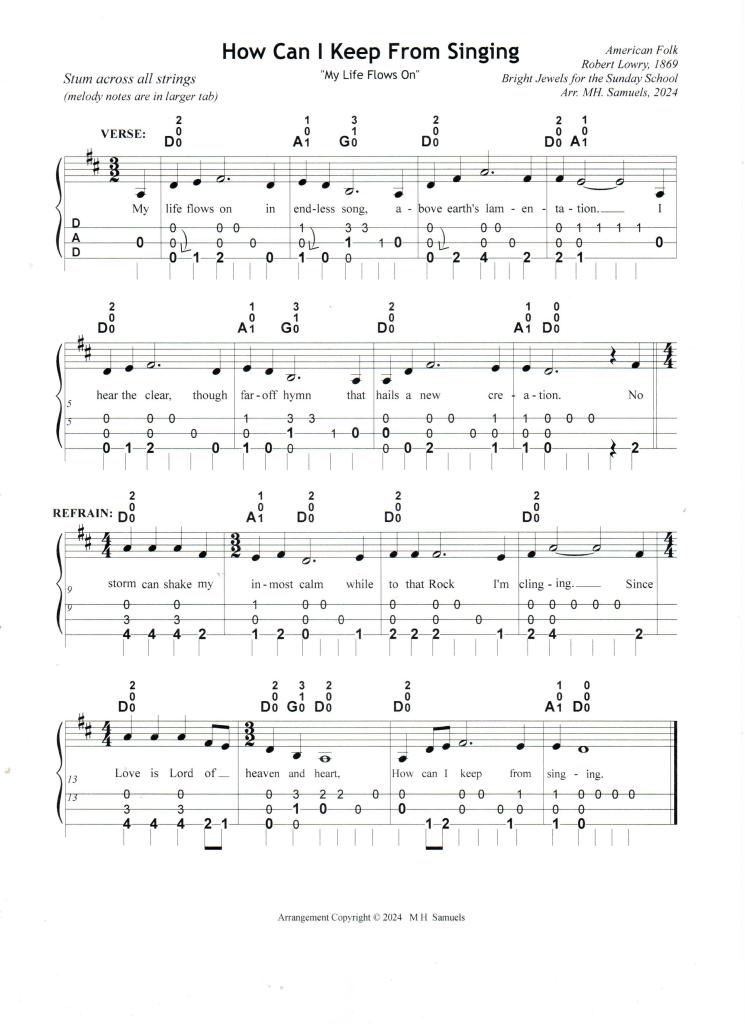
References:
Mel Bay Publishers: https://www.melbay.com/Products/CategoryCenter/D09/dulcimer-mountain.aspx
Larry Conger, DulcimerICan Music: https://www.larryconger.com
Sheet Music Plus: https://www.sheetmusicplus.com/en/category/arrangeme/969/larry-conger%2Fdulcimerican-music/?Ns=salesRank%7C1&isPLP=1&aff_id=736551
